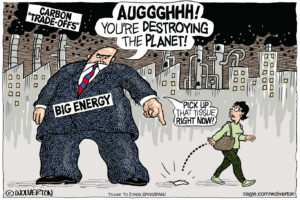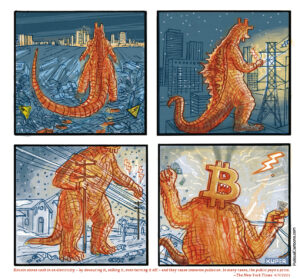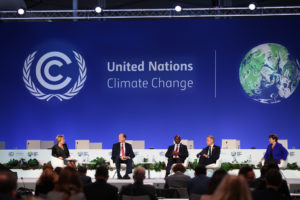Why Earth Will Never Freeze Over
The discovery of a biological mechanism that halts rapid global cooling suggests the planet can protect itself from a complete deep freeze. Climate scientists have found a "bottom line" carbon dioxide level in ancient ice cores. (David Newman / Flickr)
Climate scientists have found a "bottom line" carbon dioxide level in ancient ice cores. (David Newman / Flickr)
By Tim Radford / Climate News Network
Scientists think they now know something profound about the Ice Ages. In a world in which carbon dioxide levels in the atmosphere fall to a new low, and the glaciers advance from the poles to the temperate zones, a mechanism kicks in to halt the process. That is: the Earth cannot become a frozen zone.
Such a thing may have happened in the very distant past — there is inconclusive evidence for a “Snowball Earth” in which ice might have reached the equator, more than 700 million years ago, before complex life colonised the land or the seas. But conditions now, including the presence of growing plants, suggest that planet Earth can only get so cold before it warms up again.
This is climate research at bedrock level. Climate scientists know that the planet is warming, and dangerously, as a consequence of ever higher carbon dioxide levels in the atmosphere thanks to changes humans have made to the planet’s atmospheric chemistry – and they know it can get worse.
Freeze and Thaw
But at the baseline of climate science is a long-standing puzzle. Long before the first human ancestor struck a fire with a spark from a flint, there were Ice Ages, interspersed with warm periods. Carbon dioxide levels rose, and fell. Glaciers retreated, and then advanced. Why? What made these things happen? And will they go on happening?
Two researchers at the Autonomous University of Barcelona in Spain report in Nature Geoscience that they think they know the bottom line. They measured evidence of atmospheric carbon dioxide, trapped in ancient ice cores, and found a lower limit.
“We noticed that atmospheric CO2 concentrations hovered close to 190 parts per million (ppm) during much of the last 800,000 years but rarely fell any lower,” says Sarah Eggleston, a researcher at the university’s Institute of Environmental Science and Technology.
“This was surprising, because it suggests that these very low CO2 concentrations were quite stable. What’s more, we know that CO2 was often very high in the distant geological past, but we have no evidence that CO2 concentrations were ever lower than 190ppm.”
One research team recently established the orbital cycle conditions liable to tip the planet into an Ice Age. But due to human-induced global warming, the next Ice Age has already been severely delayed.
“A runaway greenhouse effect may indeed be possible, but a runaway freeze seems unlikely.”
Yet another research team believes it has identified some of the patterns of biogeological change that accompany the end of an Ice Age. And earlier research into ancient climates has confirmed that greenhouse-driven warming could all but erase the ice, and change the world dramatically.
Now, climate scientists know something else: that there is a lower limit to carbon dioxide levels. A runaway greenhouse effect may indeed be possible, but a runaway freeze seems unlikely.
The scientists know that in the past, carbon dioxide proportions in the atmosphere may have risen to 800ppm. For most of human history, they have been stable at around 280ppm. The explosion in fossil fuel use over the last 200 years has increased CO2 levels to 400 ppm and global average temperatures have climbed by 1°C. They could get a lot higher this century, unless nations drastically curtail fossil fuel use.
The finding – and like all research findings, it will look more convincing when confirmed separately by other studies – seems to add substance to the Gaia Theory proposed decades ago by Britain’s James Lovelock. He argued that, collectively but unconsciously, living things tended to maintain a stable range of environments for life.
Life as Regulator
The Barcelona scientists suggest tentatively that the biosphere played a role in halting the plummeting temperatures. At very low levels of CO2, plants and plankton would find it hard to photosynthesize, so they would grow only slowly. Slow growth would leave less carbon in the soils and ocean, and more would stay in the atmosphere: if so, life serves as a kind of regulator to stop the planet getting too cold for life.
And they know that the controlling process must be biological rather than geological.
“We know that, over hundreds of thousands of years, CO2 is regulated by slowly reacting with exposed rocks,” says Professor Eric Galbraith, who led the study.
“But this would be too slow to explain the stability during periods of only a few thousand years, as we see in the ice cores. So it must have been some other mechanism that kicked in at very low CO2.”
Your support matters…Independent journalism is under threat and overshadowed by heavily funded mainstream media.
You can help level the playing field. Become a member.
Your tax-deductible contribution keeps us digging beneath the headlines to give you thought-provoking, investigative reporting and analysis that unearths what's really happening- without compromise.
Give today to support our courageous, independent journalists.






You need to be a supporter to comment.
There are currently no responses to this article.
Be the first to respond.